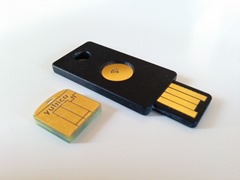 Protecting the information you keep online is becoming more important than ever. Having an extra layer of protection is almost required as a single password just does not cut it anymore. Therefore, two-factor authentication has become more popular recently. The knock against two-factor authentication is the extra steps taken to get to your data and the extra hassle it creates. But, now enjoying the benefits of two-factor authentication without the hassle is possible with the Yubikey.
Protecting the information you keep online is becoming more important than ever. Having an extra layer of protection is almost required as a single password just does not cut it anymore. Therefore, two-factor authentication has become more popular recently. The knock against two-factor authentication is the extra steps taken to get to your data and the extra hassle it creates. But, now enjoying the benefits of two-factor authentication without the hassle is possible with the Yubikey.
Two-factor authentication explained
In a nutshell, two-factor authentication is using two different types of identification to verify you are who you say you are. And, you may have already been using it this extra layer of protection.
Banking and email accounts have been employing two-factor authentication for some time now. You may have seen a bank, for example, prompt you for another kind of identification because the computer you are using is detected as being different. They will make you go through another round of questions to verify your identity.
You have also been using it at the ATM, and my not realize it. When someone gets access to your ATM care, for example, they only have one barrier to entry into your bank account. They also need a pin number to get any further. This is a primitive form of two-factor authentication.
YubiKey takes the headache out of two-factor authentication
Yubikey is a small hardware device that looks similar to a USB drive and is designed to make two-factor authentication on the web easy. In addition to your normal username and password for a given website, it acts as your second form of authentication. Once you’ve registered it, you can use this device with a variety of websites or services that support two-factor authentication. Additionally, you can use Yubikey as a second method of authentication for your computer login, disk encryption for a hard drive, or password manager.
How does YubiKey Work?
Once you’ve registered your Yubikey with a website or service that supports two-factor authentication, you simply insert the key into the computer, and then tap or touch it to provide your second method of authentication. Bear in mind that the Yubikey is not a biometric device. Similar to an ATM card, its identity protection power lies in the fact that is a physical hardware token. This prevents phishing, malware and other attacks that would need your physical key (in addition to your password) to breach your account.
Yubikey attaches to your keychain to help you keep up with it. Many fear that it would be easy to lose and if you just throw it in your pocket or purse then that is a valid concern. But, if you attach it to your keychain it will be easier to keep up with. If you do lose the YubiKey, there are measures that can be taken to gain a new one and access your accounts.
You can also use fingerprints and other biometric data. This improves two-factor authentication significantly, since it is difficult to fake.
Fingerprints are used in biometric authentication as a way of verifying a user’s identity based on their unique physical characteristics. Biometric authentication systems scan and compare the patterns of ridges, valleys, arches, loops, and whorls on a user’s finger to a stored template in a database. While there are other types of passwordless authentication methods, the fingerprint is the one used on this device.
To protect user accounts, applications and networks from unauthorized access, two-factor authentication (2FA) requires users to verify their identity with two pieces of evidence. This is also called two-step verification.